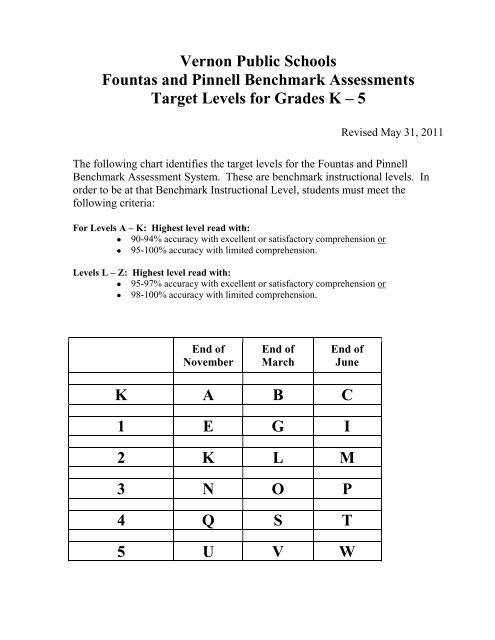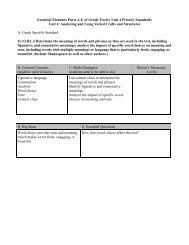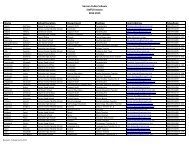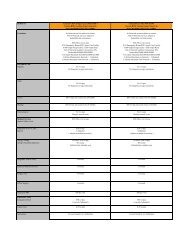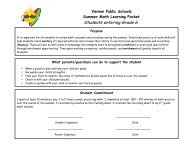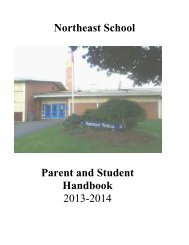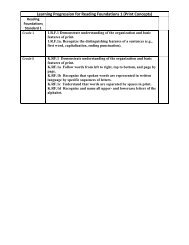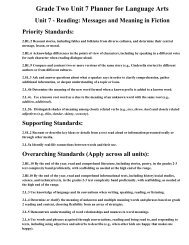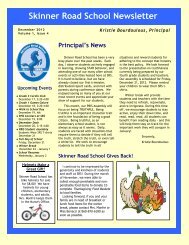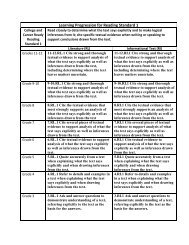Explanation of the Reading Level Assigned to Students
Explanation of the Reading Level Assigned to Students
Explanation of the Reading Level Assigned to Students
Create successful ePaper yourself
Turn your PDF publications into a flip-book with our unique Google optimized e-Paper software.
Vernon Public Schools<br />
Fountas and Pinnell Benchmark Assessments<br />
Target <strong>Level</strong>s for Grades K – 5<br />
Revised May 31, 2011<br />
The following chart identifies <strong>the</strong> target levels for <strong>the</strong> Fountas and Pinnell<br />
Benchmark Assessment System. These are benchmark instructional levels. In<br />
order <strong>to</strong> be at that Benchmark Instructional <strong>Level</strong>, students must meet <strong>the</strong><br />
following criteria:<br />
For <strong>Level</strong>s A – K: Highest level read with:<br />
● 90-94% accuracy with excellent or satisfac<strong>to</strong>ry comprehension or<br />
● 95-100% accuracy with limited comprehension.<br />
<strong>Level</strong>s L – Z: Highest level read with:<br />
● 95-97% accuracy with excellent or satisfac<strong>to</strong>ry comprehension or<br />
● 98-100% accuracy with limited comprehension.<br />
End <strong>of</strong><br />
November<br />
End <strong>of</strong><br />
March<br />
End <strong>of</strong><br />
June<br />
K A B C<br />
1 E G I<br />
2 K L M<br />
3 N O P<br />
4 Q S T<br />
5 U V W
<strong>Explanation</strong> <strong>of</strong> <strong>the</strong> Fountas and Pinnell <strong>Reading</strong> <strong>Level</strong>s<br />
<strong>Assigned</strong> <strong>to</strong> Individual <strong>Students</strong><br />
Vernon public elementary schools assess students’ reading levels at <strong>the</strong> end <strong>of</strong> each<br />
trimester using <strong>the</strong> Fountas and Pinnell Benchmark Assessment System.<br />
<strong>Students</strong> are tested individually using <strong>the</strong> following procedure. They read orally from<br />
a leveled text for a few pages. The teacher records <strong>the</strong>ir errors and fluency.<br />
They <strong>the</strong>n finish <strong>the</strong> text silently. The teacher asks comprehension questions <strong>to</strong><br />
determine <strong>the</strong>ir understanding at this level. If <strong>the</strong>y read fluently, make few errors and<br />
understand <strong>the</strong> text, a higher level is assessed. The testing continues until <strong>the</strong> student<br />
reaches a point <strong>of</strong> frustration. Through this process, <strong>the</strong> teacher identifies <strong>the</strong><br />
student’s independent, instructional, and frustration reading levels.<br />
The chart below shows <strong>the</strong> range <strong>of</strong> expected reading levels for each grade.<br />
An example:<br />
Grade 5 students should be<br />
reading in <strong>the</strong> range marked<br />
S-W.<br />
At <strong>the</strong> end <strong>of</strong> <strong>the</strong> year, <strong>Level</strong> S<br />
and T would be on <strong>the</strong> low end<br />
<strong>of</strong> <strong>the</strong> range.<br />
<strong>Level</strong> V and W would be on<br />
<strong>the</strong> high end <strong>of</strong> <strong>the</strong> range.<br />
<strong>Level</strong>s X, Y and Z would be<br />
considered above grade level.


